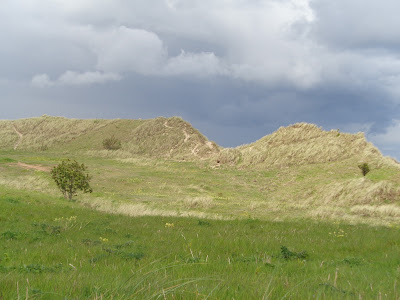After walking part of the South West Coastal Path in Cornwall in 2017, I was eager to do more coastal walking in the UK, but it was only earlier this summer that I got a chance to return to England. Given I was going to be based in Newcastle upon Tyne for part of the visit, I decided to walk part of the Northumberland Coastal Path which runs for 62 miles from Creswell to Berwick on Tweed, just south of the Scottish border.
Amble is a small town at the mouth of the River Coquet. Originally a farming community, it became a coal exporting center when mining opened in the area in the 19th century and then fishing and shipbuilding became important. Nowadays, tourism is a big part of the economy and the town has a bustling and modern marina.
Quite a contrast to the High Street where the buildings retain their old-world charm. It's easy to see that the need to park cars was never a consideration when the town was built.
The weather looked ominous as we set off alongside the River Coquet toward our first stop, Warkworth.
Just over a mile into our walk, we arrived at Warkworth Castle. The castle dates back to the 12th century. In 1327 it was besieged by the Scots and thereafter played a prominent role in the long war between England and Scotland. In 1332 Edward III granted the castle to Lord Henry Percy and, apart from a few periods when the family was out of favor with the king of the time, the Percy family retained the grant until 1922 when the castle was given back to the state.
Most of the castle is in ruins with the exception of the Gatehouse which was restored in the 1920s and the Great Tower but it's still an impressive sight.
 |
| View of the castle from outside the grounds |
 |
| The approach to the Gatehouse |
 |
| The Carrickfergus Tower partially collapsed in the 18th century. |
I enjoyed looking around the inside of the Great Tower which was the original principal residence for Henry Percy's grandson (also named Henry) who was the first Earl of Northumberland. The rooms are bare but with the help of well-placed information boards, it's not hard to picture what it would have been like.
 |
| The Kitchen |
 |
| The Buttery and Pantry |
The view from the top of the Great Tower. You'd certainly be able to see the enemy coming!
Continuing on from the castle the path takes you alongside the River Coquet into the village of Warkworth.
We did have some breaks in the clouds. And even with the clouds, the temperature was perfect for walking so we couldn't complain. Besides, the unpredictable weather is probably responsible for Northumberland being named an area of outstanding natural beauty. Despite the miles of beautiful beaches, the lack of consistent sunshine and warmth has deterred all but the hardiest of tourists in the past which means there has been very little development along the coastline.
By the time we got into the village, it was well past lunchtime so we stopped off at The Mason Arms for a well-earned rest before heading across the ancient Warkworth Bridge for the next phase of the walk.
Within ten minutes we were heading toward the coast. There were very few other walkers about, but maybe that was due to the constant threat of rain.
 |
| Don't you hate crowded beaches? |
 |
| Wildflowers in full bloom add to the beauty. |
 |
| Yikes! Up until this point the path was relatively flat. |
 |
| The sea is somewhere behind those dunes, isn't it? |
 |
| Soon we were walking past farmers' fields and hedgerows. |
 |
| But finally, our destination came into view with its pretty multicolored buildings. And could that possibly be blue sky ahead? |
The road bridge across the estuary into Alnmouth is a grade II listed structure built in 1864 called the Duchess Bridge. The stone side of it is just visible on the right of the metal bridge below. Being so old the bridge isn't wide enough for cars and pedestrians so the latter have to use the metal walkway. I can't help wondering whether the designers couldn't have come up with something a little more attractive and in line with the old bridge.
 |
| One final bridge to cross. |
 |
| The view back over the estuary from Alnmouth after we crossed the bridge. Where did the blue sky go? |
Ten minutes to go, but the rain couldn't wait. The skies opened in a torrential downpour. By the time we got to our hotel, we were soaked through.
But looking on the bright side - it could have rained all day.
Mel writes contemporary fiction with a twist of mystery and suspense and the Detective Rigby series.
For more information about her books visit her website, or sign up for her newsletter.










So wonderful seeing England again in this way...marvelous blend of narrative and visuals. Thank you so much for sharing.
ReplyDeleteThis is Regina
DeleteGlad you enjoyed it, Regina.
DeleteMel, so great to see you back on the road! Funny enough, we were in Newcastle in May and visited Alnwick Castle, one of the Duke of Northumberland’s as well. Small world, huh?
ReplyDeleteKaren, hope you enjoyed your time in the North East. Alnwick Castle (and the gardens) is beautiful but sadly I didn't have enough time to include that on this trip as I wanted to keep as close to the path as possible.
Delete